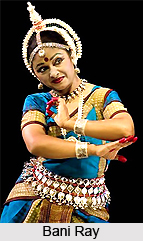 Bani Ray has been reckoned as one of the exponents of the traditional art form, Odissi. Her interest in the dance form began to take shape when she was at her tender age of six years.
Bani Ray has been reckoned as one of the exponents of the traditional art form, Odissi. Her interest in the dance form began to take shape when she was at her tender age of six years.
However she has bagged the opportunity of being trained under the aegis of some renowned gurus. She has started receiving training in Odissi style of dance since the year 1970. Bani Ray has been trained under the guidence of Hari Krishna Behera, Valmiki Banerjee, Guru Shri Durga Charan Ranbir, and the Late Guru Shri Nath Raut. Through her performances she has always been able to capture the attention of her audiences. Apart from exhibiting her excellence in the Odissi style of dance, she has also proved her brilliance in the dance forms Mohini Attam, Manipuri and several other folk dance forms.
Like many other Indian Classical dancer, Bani Ray has also exhibited her outstanding performances throughout India and United States of America. As a recognition to her astonishing talent in the arena of Odissi dance she has been conferred a number of scholarships, fellowships and accolades. Apart from being an accomplished dancer, Bani Ray has also served as the joint director of Nehru Institute of Odissi Research and Training in Delhi, India. While serving this post, she has organized several international seminars, conferences and training programmes to her credit for the budding young dancers who want to establish their impression in this domain.
Bani Ray at the present time is serving as the faculty at the Lotus Music and Dance Studios in midtown Manhattan as she is residing at Princeton, New Jersey. Like many other Odissi dancer she is also striving for the betterment of the repertoire of the Odissi style of dance. For that she is pursuing a research on the compositions of the late illustrious Guru Deba Prasad Das. In her choreogrphies and performances she always aims at incorporating the repertoire that were composed by Guru Deba Prasad Das. Her creative performances, her costume style, her technique, artistic graceful style have received rave reviews from the dance critic and leading connoisseurs of dance. Media has also given extravagantly enthusiastic review on her performances.



















